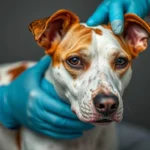
Introduction
Cherry eye is a condition that affects the third eyelid of dogs, leading to a noticeable protrusion of the gland. While it may seem like a minor issue, recognizing and addressing cherry eye is crucial for maintaining your dog’s overall health and well-being. This article aims to educate dog owners about the breeds that are prone to cherry eye, the implications of this condition, and the best practices for care and prevention.
Understanding Cherry Eye
What is Cherry Eye?
Cherry eye refers to the prolapse of the nictitating membrane, or the third eyelid gland, which is a pocket of tissue located in the inner corner of a dog’s eye. This gland is responsible for producing a significant portion of the eye’s tear film, which keeps the eye lubricated and free from infection. When the gland prolapses, it appears as a red, swollen mass in the eye, resembling a cherry—hence the name.
Symptoms of Cherry Eye
The symptoms of cherry eye can be both visible and behavioral:
- Visible Symptoms: The most noticeable sign is the swollen, red mass in the dog’s eye. This can occur in one or both eyes and may be accompanied by excessive tearing.
- Behavioral Symptoms: Dogs may exhibit signs of discomfort such as rubbing their eyes, squinting, or excessive blinking. They may also show signs of irritability or reluctance to engage in normal activities.
If you notice these symptoms, it’s essential to seek veterinary care promptly to prevent complications.
Breeds Prone to Cherry Eye
List of Common Breeds
Certain breeds are genetically predisposed to cherry eye due to their anatomical features. Here are some of the most common breeds known for this condition:
- Bulldogs: Their facial structure often leads to eye problems, including cherry eye.
- Cocker Spaniels: This breed has a higher incidence of cherry eye due to their eye shape.
- Pugs: With their prominent eyes, Pugs are more susceptible to this condition.
- Shih Tzus: Their flat faces can contribute to eye issues.
- Boston Terriers: Similar to Pugs, their eye structure makes them prone to cherry eye.
Characteristics of Prone Breeds
The breeds susceptible to cherry eye often share specific physical traits, such as:
- Facial Structure: Many of these breeds have brachycephalic features, meaning they have short noses and flat faces, which can lead to eye strain.
- Eye Shape: Dogs with bulging eyes are more likely to experience issues with the third eyelid.
- Hereditary Factors: Genetic predisposition plays a significant role, making it essential for owners to be aware of their dog’s lineage.
Causes of Cherry Eye
Genetic Factors
Research indicates that cherry eye is largely hereditary. Certain breeds have a genetic predisposition due to the structure of their eyelids and the strength of the connective tissues that hold the gland in place. Understanding these risks can help prospective dog owners make informed decisions about breed selection.
Environmental Factors
While genetics play a significant role, environmental factors can also exacerbate the issue. Common contributors include:
- Lifestyle: A dog’s physical activity level and exposure to allergens can influence the likelihood of developing cherry eye.
- Irritants: Dust, smoke, and other environmental irritants can lead to inflammation, making it easier for the gland to prolapse.
Diagnosis of Cherry Eye
Veterinary Examination
Diagnosing cherry eye typically involves a thorough veterinary examination. The veterinarian will assess the eye for swelling and may perform additional tests to determine the condition’s severity. Early detection is crucial, as it can help prevent further complications such as chronic irritation or infection.
Differential Diagnosis
Several conditions can mimic cherry eye, including:
- Conjunctivitis: Inflammation of the eye’s lining that can cause redness and discharge.
- Tumors: Growths in or around the eye that may appear similar to a prolapsed gland.
A thorough veterinary evaluation is essential to ensure an accurate diagnosis and appropriate treatment plan.
Treatment Options
Non-Surgical Treatments
Initial treatment for cherry eye may involve non-surgical options, particularly in mild cases. These can include:
- Eye Drops and Ointments: Prescription medications may help reduce inflammation and promote healing.
- Home Remedies: Keeping the eye clean and free of irritants can help alleviate symptoms. However, always consult with a veterinarian before trying home remedies.
Surgical Treatments
In more severe cases, surgical intervention may be necessary. Common surgical procedures include:
- Gland Repositioning: The most common surgery involves repositioning the gland to its normal location. This procedure aims to preserve the gland’s function and reduce the risk of recurrence.
- Removal of the Gland: In rare cases where the gland cannot be saved, it may need to be removed. This is generally considered a last resort due to the potential for long-term dry eye issues.
Each surgical option comes with its own risks and benefits, so discussing these thoroughly with your veterinarian is essential.
Post-Treatment Care
Recovery Process
The recovery timeline will vary depending on the treatment method used. With surgical intervention, expect a few weeks of healing time. During this period, monitor your dog for any signs of complications, such as increased swelling or discharge.
Long-term Management
To ensure the best outcome after treatment, follow these care recommendations:
- Regular Check-ups: Schedule follow-up visits with your veterinarian to monitor your dog’s eye health.
- Home Care: Maintain a clean environment and manage any underlying conditions, such as allergies, that may contribute to eye issues.
Preventing Cherry Eye
Responsible Breeding Practices
Choosing a reputable breeder is crucial for minimizing the risk of cherry eye. Responsible breeders should:
- Screen Breeds: Conduct genetic testing to identify predisposed breeds.
- Educate Owners: Provide information on potential health issues related to the breed.
General Eye Care Tips
Routine eye care is essential for dogs prone to cherry eye. Consider these tips:
- Regular Eye Checks: Look for signs of irritation or redness regularly.
- Maintain Cleanliness: Clean around the eyes to prevent irritants from accumulating.
Conclusion
Awareness and understanding of dogs prone to cherry eye are vital for ensuring their health and happiness. If your dog belongs to a breed known for this condition, proactive care and regular veterinary consultations can significantly improve their quality of life. Always consult with your veterinarian for personalized strategies to maintain your dog’s eye health and overall well-being.
FAQs
Common Questions About Cherry Eye
-
What is the long-term prognosis for dogs with cherry eye?
Most dogs recover well with appropriate treatment. However, some may experience recurrence or develop dry eye if the gland is removed. -
Can cherry eye reoccur after treatment?
Yes, there is a possibility of recurrence, especially if the underlying causes are not addressed. -
Is cherry eye a painful condition for dogs?
While cherry eye itself is not usually painful, the irritation and discomfort it causes can lead to secondary issues if not treated promptly.









